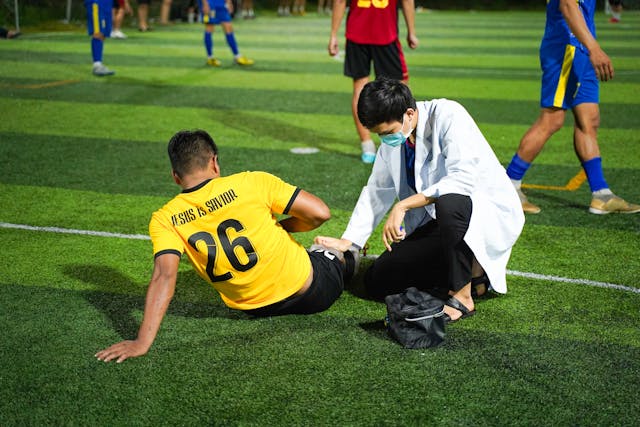
Participating in sports is an excellent way to stay active, build skills, and foster teamwork. Even with the best preparation and care, sports injuries can occur. These injuries can sideline athletes and disrupt their training schedules. Understanding common sports injuries and recovery approaches can help athletes and coaches minimize downtime and return to activities optimally.
Sports Injuries
Sprains and strains are two of the most common sports injuries among athletes. A sprain happens when ligaments are overstretched or torn, often occurring in the ankles, wrists, or knees during sudden movements. On the other hand, a strain refers to an overstretched or torn muscle or tendon, typically caused by repetitive motion or overexertion.
Recovery from sprains and strains often involves the R.I.C.E. method (Rest, Ice, Compression, and Elevation). Resting the injured area prevents further damage, while ice and compression reduce swelling. Elevating the affected limb helps improve blood flow and decreases inflammation. Once advised by a professional, light stretching and strengthening exercises can be reintroduced to support healing.
Tendinitis and Overuse Injuries
Tendinitis results from the overuse of a tendon, causing inflammation and pain. Athletes involved in repetitive movements, such as running, swimming, or tennis, are frequently at risk of developing this condition. Common examples include tennis elbow and Achilles tendinitis.
Preventing tendinitis and other overuse injuries often involves diversifying training activities to avoid repetitive strain on the same joints. If injured, resting the affected area is key. Gradually reintroduce activity once the pain subsides, assuring proper technique. Ignoring discomfort may lead to chronic injuries that take longer to heal, so addressing symptoms early is key to recovery.
Fractures and Dislocations
Fractures and dislocations are more severe injuries that sometimes occur in high-contact or high-impact sports. A fracture involves a break in the bone, whereas a dislocation happens when a bone is forced out of its joint. These injuries can be painful and typically require medical attention to assure proper healing.
Management of fractures and dislocations often includes immobilizing the affected area with a cast or splint, giving the body time to repair itself naturally. Once physicians allow, athletes can begin carefully tailored rehabilitation exercises to regain strength and mobility. Preventative measures, such as wearing sport-appropriate gear and padding, can reduce the risk of these injuries.
Recovery and Injury Prevention – Key Strategies
Recovering from sports injuries is a key part of every athlete’s wellness routine. These practices are cornerstones of both injury recovery and prevention, creating a well-rounded approach to staying active and healthy. Below are helpful tips for both recovery and prevention:
- Prioritize Warm-Up and Cool-Down Routines
Warming up gently increases blood flow and prepares the body for physical activity. Cooling down stretches helps reduce muscle soreness post-exercise.
- Listen to Your Body
Any unusual pain or discomfort during training might indicate an issue. Rest or seek advice immediately if needed to prevent worsening injuries.
- Use Proper Equipment
Making sure everything from footwear to helmets fits correctly and offers adequate protection is key to minimizing risks in sports.
- Stay Hydrated and Eat Nutritiously
Proper hydration and a balanced diet help optimize muscle function and repair.
- Strengthen Stability and Flexibility
Incorporating exercises such as yoga or resistance training into your routine for your muscles and joints endure pressure better during play.
Also Read: Preparing for Sports Physicals: Essential Health Checks You Need
Final Thoughts
Sports injuries can be an inevitable part of an athlete’s life, but understanding the common types and how to recover thoughtfully can make all the difference. For athletes seeking to minimize risks, injury prevention techniques should become a regular part of their fitness routine. Whether you’re a seasoned athlete or just starting, prioritizing health through recovery strategies and preventative measures assure a more fulfilling sports experience.








